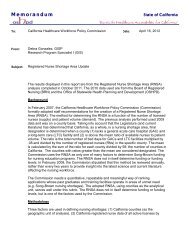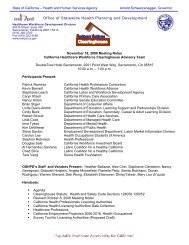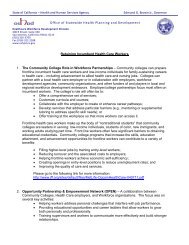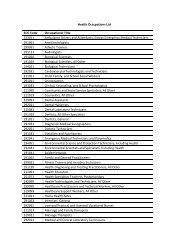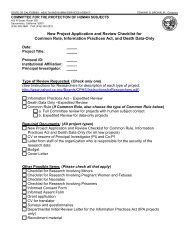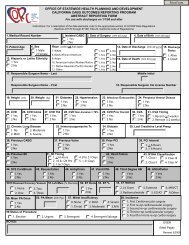Best Practices for Project Management, Design, and Construction of ...
Best Practices for Project Management, Design, and Construction of ...
Best Practices for Project Management, Design, and Construction of ...
You also want an ePaper? Increase the reach of your titles
YUMPU automatically turns print PDFs into web optimized ePapers that Google loves.
Instruction Bulletins (IBs), prepared by the design pr<strong>of</strong>essional in responsible charge, are used to<br />
prevent undue construction delays. IBs that materially alter the work must be submitted <strong>and</strong><br />
reviewed as ACDs. Only after approval <strong>of</strong> an ACD by OSHPD FDD field staff can any ACD<br />
construction commence. FDD field staff need to evaluate the IB (converted to an ACD) <strong>for</strong> its<br />
construction delay potential.<br />
The following practices are recommended <strong>for</strong> the design team:<br />
• Do not approve changes <strong>for</strong> convenience. The project manager should communicate this<br />
with the contractor(s) during the preconstruction meeting. Rarely do<br />
contractor-recommended changes actually save money <strong>for</strong> the project because <strong>of</strong> the<br />
ensuing delay <strong>for</strong> the modification <strong>of</strong> the approved plans <strong>and</strong> the approval <strong>of</strong> OSHPD<br />
FDD.<br />
• Avoid making changes to the approved documents. ACDs can number into the hundreds<br />
depending on the quality <strong>of</strong> the construction documents <strong>and</strong> contractor-requested<br />
changes that are approved by the owner representative. Although the argument is <strong>of</strong>ten<br />
made that a change will improve the schedule <strong>and</strong> reduce cost, such is rarely the case<br />
when delays <strong>and</strong> work coordination issues are factored in.<br />
• Maintain a management file <strong>for</strong> ACDs that tracks the status <strong>of</strong> each <strong>and</strong> assigns<br />
responsibility <strong>for</strong> required completion.<br />
• Maintain a management file <strong>for</strong> deferred submittals submitted to OSHPD that tracks the<br />
status <strong>of</strong> each <strong>and</strong> assigns responsibility <strong>for</strong> required completion.<br />
• Maintain a Request <strong>for</strong> In<strong>for</strong>mation (RFI) or similar instruments <strong>of</strong> service file that identifies<br />
any required changes resulting from the directive <strong>of</strong> the design team. The IOR should<br />
review each RFI to ensure that the necessary ACD documentation is provided by the<br />
design team.<br />
• The architect should accompany the IOR <strong>and</strong> OSHPD FDD field staff during observation<br />
<strong>of</strong> the construction work. Many issues can be resolved immediately on site, thereby<br />
avoiding ACDs. If an ACD is required, the designer can discuss the issue with the OSHPD<br />
FDD field staff <strong>and</strong> mutually agree upon the specific details that the ACD should be<br />
addressed. This simple process can avoid costly delays.<br />
Owner<br />
<strong>Project</strong> management varies from owner to owner. Some owners have staff dedicated to projects<br />
<strong>and</strong> some depend largely on consultants. Because owner changes are one <strong>of</strong> the major factors<br />
associated with project delays <strong>and</strong> associated problems, once the project permit is issued owners<br />
should resist the urge to make changes.<br />
The following practices are recommended <strong>for</strong> the owner:<br />
(OSHPD <strong>Best</strong> <strong>Practices</strong>) Page 83 DRAFT FINAL, Sept. 2011



